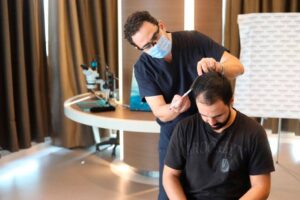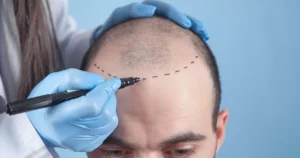Recovery matters just as much as the procedure itself — here’s how to get the best results after your transplant.
What should you do right after your hair transplant?
The first 48 hours are crucial. Keep your head elevated, avoid touching or scratching the scalp, and follow your surgeon’s exact post-op care instructions. This helps reduce swelling and protects the newly implanted grafts.
How important is the first hair wash?
Very. Most clinics recommend washing your hair 2–3 days after the procedure using a gentle, sulfate-free shampoo. Use light pressure and lukewarm water. Avoid hot water, aggressive scrubbing, or harsh towel drying.
Can I go back to work immediately?
Most people can return to work in 3–5 days, depending on the job. If your work involves physical activity or exposure to dust, consider taking more time off or asking for modified duties.
What are the biggest mistakes to avoid during recovery?
Avoid these common mistakes:
- Wearing tight hats or helmets too soon
- Smoking or drinking alcohol (slows healing)
- Intense workouts within the first 2 weeks
- Picking scabs or scratching the scalp
Each of these can damage the fragile grafts or slow down recovery.
How do I deal with itching or discomfort?
Itching is normal as the scalp heals. Use a prescribed spray or soothing lotion provided by your clinic. Do not scratch — pat gently if needed. Cold compresses can also help reduce swelling and irritation.
When does the transplanted hair start to fall out?
Shedding of the transplanted hair (called “shock loss”) usually starts 2–4 weeks after surgery. This is expected. The follicles remain intact and will begin growing new hair in 3–4 months.
What can I eat to help my recovery?
Focus on a nutrient-rich diet with:
- Lean protein (chicken, fish, eggs)
- Vitamins A, C, E
- Biotin and zinc
- Omega-3 fatty acids
These support cell repair, immune response, and healthy follicle function.
Is it okay to sleep on my side?
During the first week, it’s best to sleep on your back with your head elevated using 2–3 pillows or a travel neck pillow. This minimizes pressure and swelling. After 7–10 days, you can resume your normal sleeping position.
When can I return to exercise and sports?
Light walking is fine after a few days. Avoid high-impact activities, gym workouts, swimming, or sweating excessively for at least 10–14 days. Too much strain or friction can dislodge grafts and cause infection.
How can I tell if something’s going wrong?
Watch for signs like:
- Excessive bleeding or pus
- Fever or chills
- Intense redness beyond the grafted area
- Pain that doesn’t improve
Contact your clinic immediately if you notice any of these. Early action prevents complications.
Final thoughts: What’s the secret to a smooth recovery?
Patience, gentle care, and following instructions closely. Recovery is part of the journey, not just downtime. Those who commit to the full healing process typically enjoy the most natural, dense, and long-lasting results.





